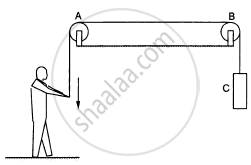Advertisements
Advertisements
प्रश्न
A body constrained to move along the z-axis of a coordinate system is subject to a constant force F given by
`F = -hati+2hatj+3hatkN`
Where `hati,hatj,hatk` are unit vectors along the x-, y- and z-axis of the system respectively. What is the work done by this force in moving the body a distance of 4 m along the z-axis ?
उत्तर
Since the body is displaced 4m among z-axis only.
`:. hatS = 0hati +0hatj+4hatk`
Also `vecF = -hati +2hatj + 3hatk`
Work Done, `W = vecF.vecS`
`= (-hati+2hatj+3hatk).(0hati+0hatj+4hatk)`
`= 12 (hatk.hatk)` joule = 12 Joule
APPEARS IN
संबंधित प्रश्न
A lawyer alleges in court that the police had forced his client to issue a statement of confession. What kind of force is this ?
When you hold a pen and write on your notebook, what kind of force is exerted by you on the pen? By the pen on the notebook? By you on the notebook?
List all the forces acting on (a) the pulley A, (b) the boy and (c) the block C in figure.

The sum of all electromagnetic forces between different particles of a system of charged particles is zero
At what distance should two charges, each equal to 1 C, be placed so that the force between them equals your weight ?
Find the ratio of the magnitude of the electric force to the gravitational force acting between two protons.
A man moves on a straight horizontal road with a block of mass 2 kg in his hand. If he covers a distance of 40 m with an acceleration of 0⋅5 m/s2, find the work done by the man on the block during the motion.
A block of mass m is kept over another block of mass M and the system rests on a horizontal surface (In the following figure). A constant horizontal force F acting on the lower block produces an acceleration \[\frac{F}{2 \left( m + M \right)}\] in the system, and the two blocks always move together. (a) Find the coefficient of kinetic friction between the bigger block and the horizontal surface. (b) Find the frictional force acting on the smaller block. (c) Find the work done by the force of friction on the smaller block by the bigger block during a displacement d of the system.

A 250 g block slides on a rough horizontal table. Find the work done by the frictional force in bringing the block to rest if it is initially moving at a speed of 40 cm/s. If the friction coefficient between the table and the block is 0⋅1, how far does the block move before coming to rest?
A body is moving unidirectionally under the influence of a source of constant power supplying energy. Which of the diagrams shown in figure correctly shows the displacement-time curve for its motion?
